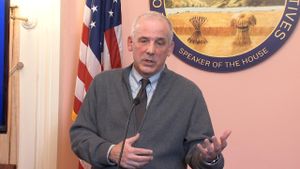Experts across California are facing the dual threat of rising fentanyl overdose deaths and the increasing prevalence of this potent synthetic opioid, which is being mixed with various street drugs. Data from 2022 reveals over 7,000 opioid-related overdose deaths statewide, with nearly 87% connected to fentanyl, highlighting the urgency of the situation.
Joseph Friedman, a resident physician at UC San Diego and researcher on substance abuse, commented, "The U.S. is an extreme global outlier when itcomes to overdose death rates," indicating the country’s crisis is exponentially worse than the global average. He noted the early days of fentanyl usage involved it primarily replacing or supplementing heroin. Nowadays, it is increasingly being found in counterfeit pills and other substances, particularly concerning for young users who might be unaware of these dangers.
Friedman explained, "Whether you obtain drugs from someone you know or from random sources, be cautious; you can’t trust any pill not procured from a licensed pharmacy." He emphasized the need for expanded access to naloxone, the emergency antidote for opioid overdoses. "Distributing more fentanyl test strips and informing people about Good Samaritan laws, which offer legal protection to those seeking help during overdoses, are effective strategies to combat this growing crisis," he added.
Even when users test drugs for fentanyl presence, there’s no guarantee of safety, as some other harmful substances may be present. He cautioned, "This is a particularly dangerous time for drug experimentation. Particularly among young people, they could inadvertently discover they’re consuming fentanyl when experimenting with what they think might be safer drugs."
Addressing the situation, Jessica Hwang from the California Department of Public Health, emphasized the importance of community involvement: "Anyone can help tackle the opioid crisis by knowing about naloxone and recognizing signs of overdose. Just carrying naloxone and raising awareness can save lives. It’s possible to significantly reduce overdose deaths if we all participate."
One of the primary setting where this crisis plays out is on college campuses. Chelsea Shover, assistant professor at the David Geffen School of Medicine, remarked on changing dynamics. Historically, adventurers in college typically viewed drug experimentation as risky but manageable. "Storytelling often portrayed them as bad-night risks, not life-and-death situations," she stated. Now, counterfeit pills laced with fentanyl are creating far deadlier odds for students.
On January 18, police responded to reports of a potential heroin overdose involving a young woman who was later discovered to have fentanyl present. She was treated with naloxone but succumbed to the overdose later on. The case led to the arrest of Martin L. Carpenter, 40, from Chicago, who is facing several serious charges, including involuntary manslaughter. He allegedly supplied the drugs later found with the victim.
According to police, Carpenter coordinated with the young woman to sell her $160 worth of heroin. This incident not only indicates the tangible consequences of fentanyl’s increasing prevalence but also highlights the legal ramifications for distribution. The surveillance and digital evidence present are set to play significant roles during his trial.
Experts warn this exchange was not isolated. According to Friedman, intentional mixing of fentanyl with stimulants is becoming increasingly prevalent, as hardcore addictions drive individuals to riskier choices. He emphasized, “Abstinence is the safest approach, but for those who choose to use, knowing the risks and harm reduction strategies is critically important.”
Hwang reiterated the importance of educational campaigns within communities and colleges to combat the stigma surrounding naloxone accessibility. Fentanyl test strips, she points out, can alert users to the presence of fentanyl—a substantial protective measure. Yet, comprehensive education is required to maximize their utility.
Friedman noted, “The drug market today is more unpredictable than even a decade ago. Variance between batches can be significant, even from the same dealer. Users must proceed with caution.”
Jessica Hwang said educational websites and community-driven resources play pivotal roles. "Facts Fight Fentanyl is one such resource to help inform people about their risks and ways they can protect themselves and others through education and drug safety.
There’s no question: the fentanyl crisis is a multifaceted problem requiring coordinated efforts across communities, educational institutions, and healthcare systems. Both prevention strategies and legal accountability will be necessary to turn the tide against this urgent public health crisis. A cohesive response will not only help save lives but also reinvigorate community trust and resilience against this synthetic scourge.
Friedman expressed optimism, stating, “With active participation from all fronts—medical professionals, law enforcement, and the public—we can significantly reduce these tragic outcomes.”
Efforts like public access to naloxone and awareness initiatives are not just necessary; they are imperative to combat the rising tide of fentanyl-related overdoses and safeguard future generations from deadly missteps.



